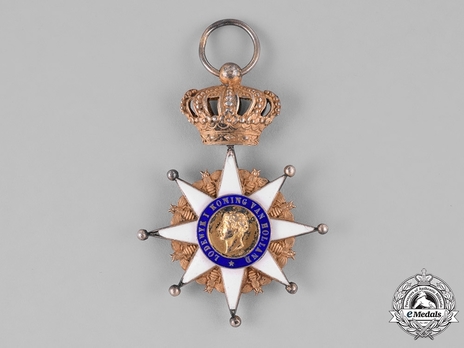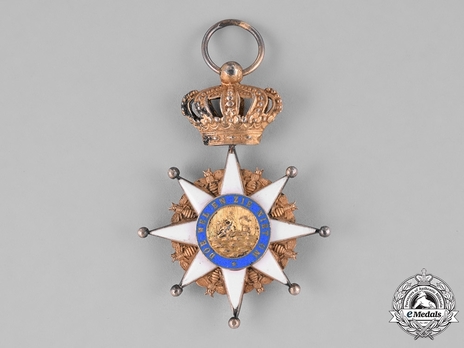Royal Order of Holland, Knight
CATEGORY: Version
SKU: 01.NLD.0106.304.01.000
Estimated market value:


Estimated market value:
Netherlands, Kingdom. A Royal Order of Holland, Knight's Badge, c.1880
(Koninklijke Orde van Holland). Instituted 1806. 1807-1814 Issue. Of late 19th century French manufacture, also known a exhibition sample, in silver gilt, consisting of an enameled white eight-pointed star with ball finials, featuring Napoleonic heraldic bees in each quadrant, obverse centre depicting an effigy of Louis I surrounded by an enameled blue border with the inscription LODEWYK I KONING VAN HOLLAND, the reverse centre featuring a swimming lion, encircle by enameled light blue border inscribed by DOE WEL EN ZIE NIET OM, the King’s personal motto, suspended by a large silver gilt royal Crown also in silver gilt, with boars head hallmark on 6 o'clock ball finial denoting French silver manufacture of 800 fineness post 1838, with illegible maker’s mark on the ring, measuring 45.83 mm (w) x 63.36 mm (h - inclusive of crown suspension and integral ball), with loss of enamels and gilt, with reverse blue enamel replaced, fair.
The Order of the Union was established by Louis Napoleon Bonaparte, King of Holland, in 1806. It underwent a number of name and design changes in its short 5-year lifespan.
The Grand Order of the Union and the Order of Merit were reunited as the Royal Order of Holland on February 13, 1807. The Royal Order of Holland was composed of 30 Grand Crosses, 50 Commanders, and 450 Knights. The King’s brother, Emperor Napoleon I of France, did not approve of the Order, and it was altered again in February 1808. The new order was called the Order of the Union. It was composed of 30 Grand Crosses, 50 Commanders, and 450 Knights (expanded to 500 Knights later in the same year). This Order introduced Collars and Breast Stars, but it was also short-lived. It was finally superseded by Napoleon’s Order of the Reunion in 1811.
The Grand Cross features an obverse inscription that translates to "Louis I, King of Holland," and a reverse inscription that translates to "Do what you ought, and come what will." There may be additional versions that differ in size.

Comments
Sign in to comment and reply.


Scroll Top